Globularia x indubia
Blooms of August, 2021. Above, the first flowers from new plant Globularia x indubia, a cross of two species. The small (1", 25mm) flowers appear in clusters.
The usual year round bloomers are, no surprise, blooming. Grevillea 'Peaches and Cream', for one. A deep soak a few weeks ago stimulated a better than usual summer flush:
'Ned Kelly', aka 'Masons Hybrid':
'Robyn Gordon'. I read this Grevillea was named for a little girl who told her dad to save this seedling because it was going to be beautiful. She died very young. Can you think of a more poignant name for a plant?
Summer means Dahlias. This year hasn't been so great, except for the formerly yellow and red striped 'Funny Face' that produced some tubers that bloomed red, and some other tubers that bloomed yellow.
'Holland Festival':
Dahlia buds bitten off. &%$*#$!! rabbits!
A few roses, because I made the effort to spray the new growth with Spinosad against Chilli Thrips:
Just the very newest growth needs treatment, before the flower buds get larger than a chocolate chip.
The Spinosad eliminates the regular Thrips, too, providing pristine white rose flowers for a change.
'Moondance':
They make for a wonderful sight in the garden, but also a for a wonderful view outside the front windows:
Day lilys flower on and on...here with a neon pink Catharanthus, which is basically an annual. If you are lucky, in Southern California you can get another year or two out of them. They look very poorly over the winter and recover with warmer weather. I cut this one back as it began to perk up in April, gave it a big hit of fertilizer...
...and it is providing another summer of clashing neon pink, to remind me I should have bought the white flowered one instead. Next year, maybe. They would provide the splashes of bright white the Shasta daisies provide in Spring.
'Bella Sera':
'Victorian Lace':
Echeveria harmsii 'Ruby Slippers' is named for its fabulous foliage color, which would be a little better with more sun. This clump is in part shade, giving it less ruby but also less heat stress. Flowers are bright, too:
The oldest (five years plus??) Calylophus 'Southern Belle''s excellent performance prompted me to buy seven more of them this spring, with varying results. It flowers like this until it goes dormant in October and sprouts afresh come spring:
Pentas, like Cathanranthus, is another heat lover from the tropics that is an annual if the winter is wet and cold, or a short lived perennial if winter is disappointingly dry, as this past one was.
Supposedly butterflies like the flowers, though I rarely see any on them. The butterflies far prefer the very ugly Senecio mandraliscae flowers.
The butterflies like these better:
Compact Leucadendron 'Harlequin' is a few feet away from the Pentas. No, it's not flowering, but it's so beautiful you want to see it anyway, right?
Orlaya grandiflora blooming late. I moved this seedling to provide some white flowers after the adjacent Rhodanthemum 'Casablanca' finished up, which it has. A rare event: something I planned actually worked.
Verbena--some look tired, some not. This one looks great paired with Sedum nussbaumerianum 'Coppertone'
Some tired/some not holds true for Trachelium caeruleum, too:
Common Myrtle, Myrtus communis (how about that--a common name almost the same as the botanical) is flowering a little late this year. This is the variegated version. Really an outstanding shrub for Southern California as it looks absolutely beautiful on no irrigation whatsoever:
Another summer heat lover (I have more than I thought I did) is the Russellia equisetiformis. I cut them all back very hard (to the ground) earlier this year and they are gorgeous again. The two on the left are the typical growth habit. The one on the right is a shrubbier, less draping version sold by Monrovia.
There's also one with peachy flowers, one with pale yellow, and a sparsely growing version if you don't want to be overwhelmed by the size. Here's the sparse version, which is, yes, sparse. Spaced out stems, and not many of them.
So, all the usual August flowers, except the Verbena, Catharanthus, and Globularia. Can't complain, even though it's August.
"Ahhhhh! Hot concrete!" says Lizzie:
Some do enjoy heat, after all.


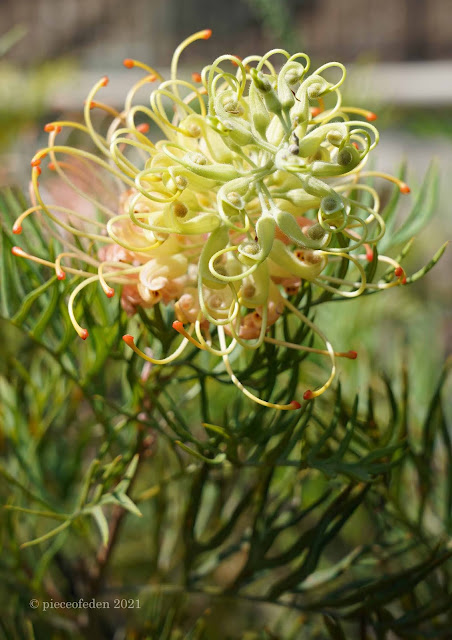





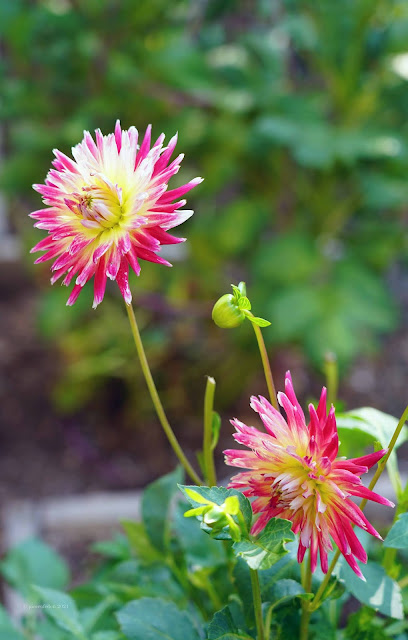


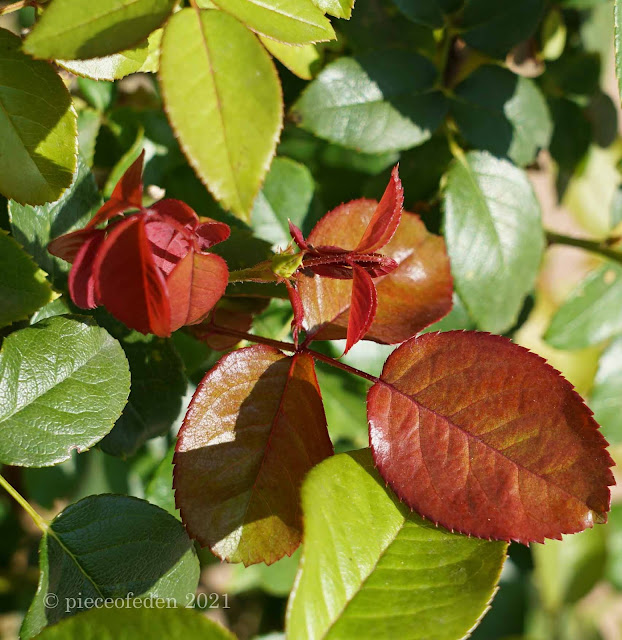




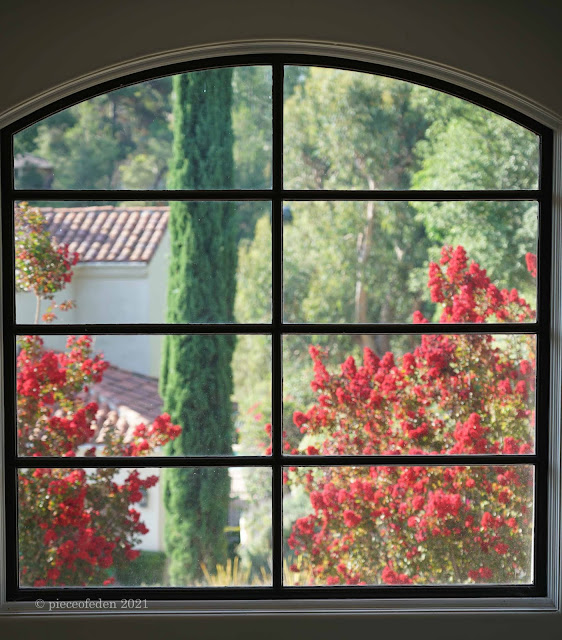



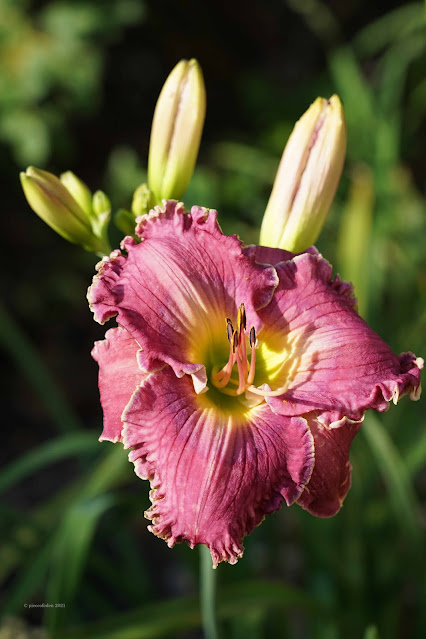
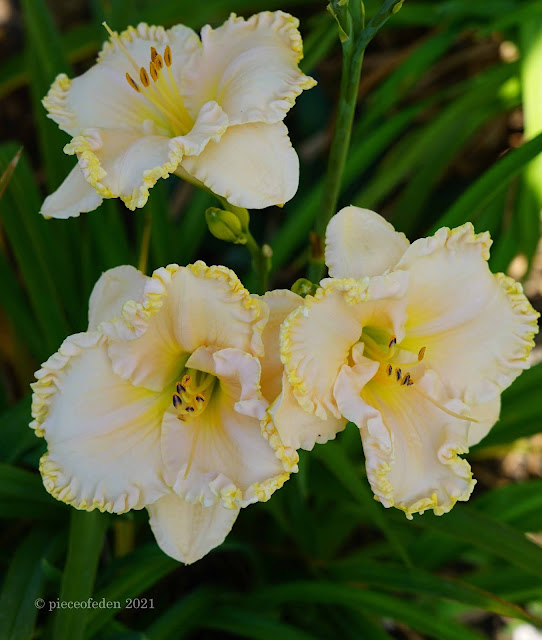





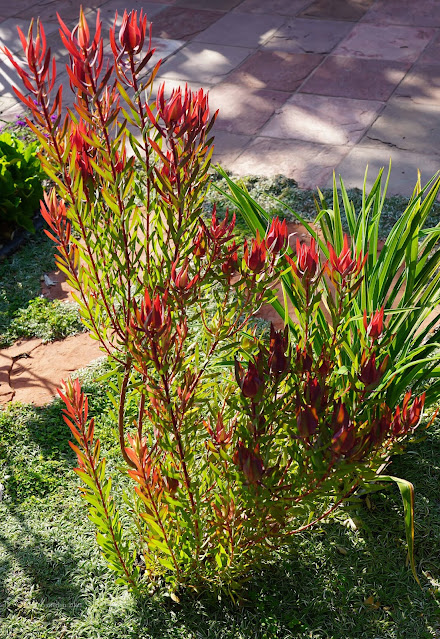







Just beautiful as always - everything. I love your windows. I see some blank spaces along your retaining wall. :)
ReplyDeleteThanks!
DeleteYeah, some blanks spaces--a planned project for fall when it cools down. The Senecio 'Mount Everest' is an experiment to hopefully eventually form dusky blue 4-5' columns along the wall growing up from the planting bed below. I walk along the top of the wall, when pulling weeds etc, and the Russellia is something of an obstacle so adding another is a hazard. There was a Xerosicyios danguyi in the blank that was supposed to drape down like the Russellia, but it was too dry for it.
Because of reflected heat, whatever is planted there needs to be extremely heat-tolerant.
Aww, I so wish I could grow Dahlias!! Alas, too much shade, so I'm enjoying yours vicariously. The Dynamite looks.... uhm.... dynamite, and especially so through your beautiful windows. Just fabulous! Happy August! So happy it's here - it usually means that the worst of summer is almost over. I can't wait for September and the cooler temps usually brought! Also, can't believe it's mid-month and Bloom Day. Took some pictures the other day. Should try to write a post - it's been a while...
ReplyDeleteDahlias definitely need sun, warm soil, and no rabbits. But in summer heat, shade sure is nice. The nights here start to cool down a few degrees in about 10 days...a sign of better weather ahead, so yeah getting past July is always a cause for celebration.
DeleteHappy blooms, Anna.
When I see those red lagerstroemia, I really wonder why that color isn't planted more? The whites and pinks are pretty, but the red -- what a knock-out!
ReplyDeleteExactly what I think, too. :^)
DeleteHa! I saw a lizard exhibiting exactly the same posture yesterday - usually they're either skittering ahead of me or doing push-ups ;) I'm glad you've managed to control the chilli thrips so we get a chance to see some of your spectacular roses. I've never seen the thrips here but then I hardy get any rose blooms during the summer months either. The behavior of the 'Funny Face' Dahlia is interesting - maybe it should be renamed 'Two Faced'?
ReplyDeleteVery true--either skittering, push ups, or sun bathing. But occasionally they'll be eating an earwig or fly--good Lizzie!
DeleteThat Dahlia clump has blooming like mad, so what ever name it wants, I'm happy to oblige!
I love the *faint* brush of red in one yellow petal (on the right-hand half of the bloom) of 'Funny Face'. That genetic material is _almost_ sorted out, but never completely.
DeleteMaybe next year it will be back to stripes. That would be fun!
DeleteWhat a grand parade of plumes. Love the lizard too.
ReplyDeleteSo lucky to have lizards in the garden! I love them.
DeleteYour blooms of August are beautiful, and your photos of the Grevillea are stunning!
ReplyDeleteGlad you liked them, thank you.
DeleteSo lucky to be able to grow Grevilleas. They are wonderful plants.
So many tired things in August around these parts. I'm trying to add more of the late season stuff, Rudbeckias and the like. There is a Globularia right by the entrance to Mendo Coast Botanical Garden and I always admire it and wish I had one . I've never bothered to look up it's hardiness zone so maybe I should start there !
ReplyDeleteXera plants has a page of species (not x indubia) that are rated to USDA 5a - 4b!!! I don't think you are quite that cold..probably the thing is--can you keep them dry enough in winter?
Deletehttps://xeraplants.com/genus/globularia/